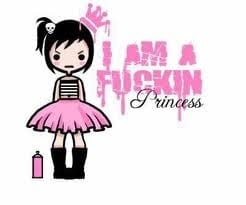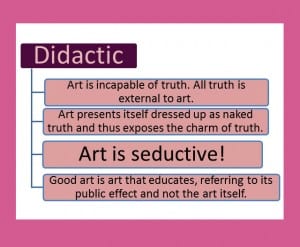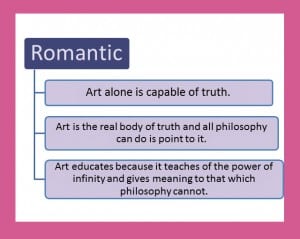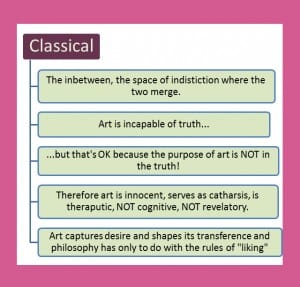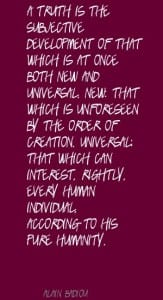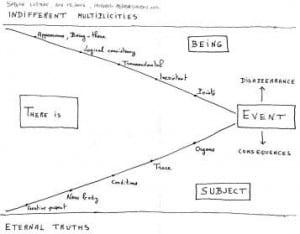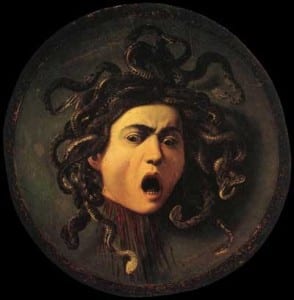ALAIN BADIOU
HANDBOOK OF INAESTHETICS
Chapter 6 – Dance as a Metaphor for Thought
Keywords: dance, spirit, thought, Nietzsche, vulgarity, lightness, breath, verticality, gymnastics, event, nominal, fixation, fulgurant, nakedness, gaze, anonymity, space, subtraction, omnipresence, gravity, slowness, music, encounter, entanglement, separation, choreography, vertigo.
In this chapter Badiou turns his attention to dance and to the connection this particular art form has with thought.
For Badiou dance is not an art form in the typical sense; dance is, as Nietzsche says, “the image of a though subtracted from every spirit of heaviness”. Dance is innocence in forgetfulness of the body’s weight; it is a continuously new beginning; it is in itself the source of movement, the affirmation that is found in the absence of the shameful body…
After having read all about Agamben I feel that dance is the state of exception where the earth and the air merge and become indiscernible…
Dance has nothing to do with gymnastics, perfect technique and military bodies… It is the body that goes against all odds, is aerial, light, “devoted to its zenith”. Dance fits in with Nietzsche’s idea of thought as an active power, as becoming. It is an affirmation of all the restraints hidden behind the body’s capacity, it is the slowness inside the quickness of the movement.
If dance “finds its essence in what has not taken place” dance is the state of potentiality it is the state where the unconstrained body manifests itself through its disobedience of any impulse, through its self-restraint through its refusal to give in to the vulgarity of performing the act it is “supposed to do .
Going back to the Nietzsche – Badiou train of thought, dance can be seen as a metaphor for thought if we take into consideration that every genuine thought depends upon an event, where “event” is that which remains undecided between taking place and non-place… If an event is defined the moment we give the thought a name, then dance is what points to the thought one step earlier, before it is given a name, before it is manifested as an event. Dance is therefore a metaphor for that which is not fixed, that which remains undecided, it shows the event before the event is named (bringing us back to dance as a state of potentiality).
Considering this, improvisation or even better authentic movement) is for me very close to being the true (if we accept the existence of such a truth) metaphor for thought. It is the movement that depicts the thought before it gains a conscious form, before we think the thought of naming the thought and turning it into an event. It si the twilight zone where movement and thought fall so much into each other that they tend to become one.
Badiou then proceeds to speak of the role of music in all of this, presenting it as the medium to bring out the silence where dance takes place, and continues to present to us his six principles of dance:
- 1. The obligation of space
- 2. The anonymity of the body
- 3. The effaced omnipresence of the sexes
- 4. The subtraction from self
- 5. Nakedness
- 6. The absolute gaze
Dance is the only art form that is constrained to space, it symbolizes the spacing of thought…
The dancing body is a “thought body”, it depicts nothing and no one, it is an emblem…
Dance manifests the two sexual positions but never names them as man – woman. It represents simply the “encounter, entanglement, separation” it its purest form of desire (and by representing the restraint it makes everything allowed because they happen in their NOT happening).
“The dancer does not dance” – Mallarme. The true dancer does not appear to know the dance she dances (interesting that dancer = she… however that brings me back to my thoughts on improvisation… Is it the true dance???)
Dance is in the nakedness prior to any “dressing up” and not in the nakedness deriving from the undressing, it is in the innocence and the purity.
In order for these principles to be met, the gaze of the spectator must not seek
Finaly the gaze directed to dance must be fulgurant and absolute just like dance itself, disappearing the moment it appears and thus kept pure and eternal in its ephemerality.
As for the statement that “dance is not an art”??? I’m sorry but thought I really do understand his follow-up and all his supporting statements, I just cannot bring myself to support it… So I will leave it at that and allow each the option to read and decide for themselves…
***
Upon reflection, there is another point upon which I disagree and at the risk of sounding disrespectful I believe I owe it to myself as dance researcher to point it out: “The dancing body does not express any kind of interiority…neither imitation nor expression…”… I believe dance IS an expression. An expression of the thought before the thought can be put into words; a facilitator at times for exposing thoughts/emotions that are beyond or before the point of verbalization. And I believe this precisely because humans are not “digital” beings. We do not go from one state to the other instantly but we are “analogue” we make transitions, however brief they may be and the states we pass through can become indiscernible. So if dance IS a metaphor for thought we can never say for sure at which point it makes the transition to being a medium of expression…
***
Another interesting point comes from a reiki approach. Our throat chakra is considered the energy point that has to do with expression of our true feelings and THOUGHTS. Reiki practitioners say that the trues form of communicating those needs is dance! It is I guess in a way the medium to express the thought before it actually becomes a conscious thought…
http://www.carlamary.net/ThroatChakra.html
Vishuddhi, Throat, Fifth Chakra Dance
http://www.youtube.com/watch?v=2My4cLQjsBE
***
An Explosive Genealogy:
Theatre, Philosophy and the Art of Presentation
http://www.cosmosandhistory.org/index.php/journal/article/view/36/72
***
How does all this potentially apply to my work?!??!?!?! Right now I HAVE NO IDEA!!!
Θα τα παρατήσω όλα και θα γίνω πριγκίπισσα…
